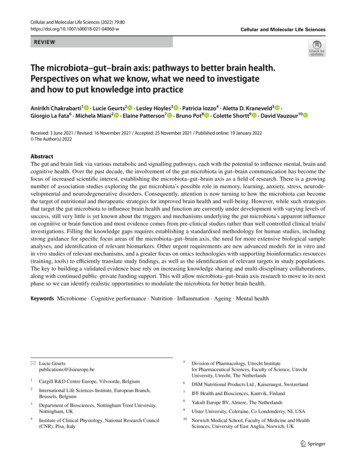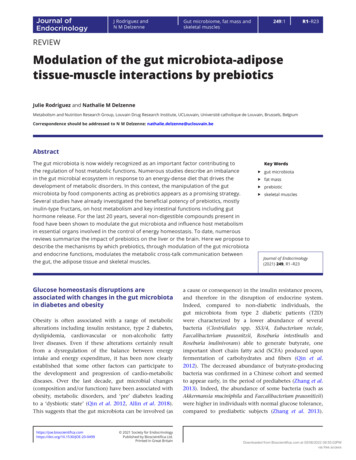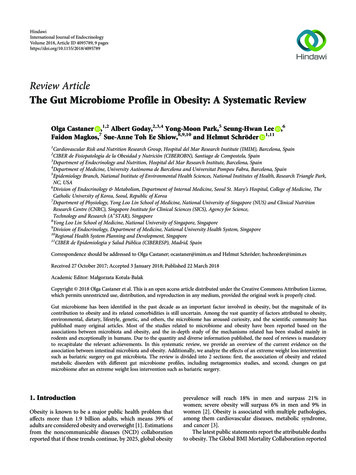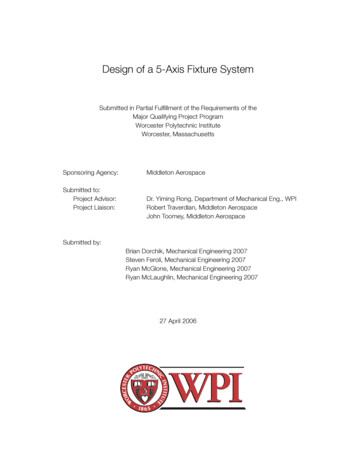
Transcription
Cellular and Molecular Life Sciences (2022) lular and Molecular Life SciencesREVIEWThe microbiota–gut–brain axis: pathways to better brain health.Perspectives on what we know, what we need to investigateand how to put knowledge into practiceAnirikh Chakrabarti1 · Lucie Geurts2 · Lesley Hoyles3 · Patricia Iozzo4 · Aletta D. Kraneveld5 ·Giorgio La Fata6 · Michela Miani2 · Elaine Patterson7 · Bruno Pot8 · Colette Shortt9 · David Vauzour10Received: 3 June 2021 / Revised: 16 November 2021 / Accepted: 25 November 2021 / Published online: 19 January 2022 The Author(s) 2022AbstractThe gut and brain link via various metabolic and signalling pathways, each with the potential to influence mental, brain andcognitive health. Over the past decade, the involvement of the gut microbiota in gut–brain communication has become thefocus of increased scientific interest, establishing the microbiota–gut–brain axis as a field of research. There is a growingnumber of association studies exploring the gut microbiota’s possible role in memory, learning, anxiety, stress, neurodevelopmental and neurodegenerative disorders. Consequently, attention is now turning to how the microbiota can becomethe target of nutritional and therapeutic strategies for improved brain health and well-being. However, while such strategiesthat target the gut microbiota to influence brain health and function are currently under development with varying levels ofsuccess, still very little is yet known about the triggers and mechanisms underlying the gut microbiota’s apparent influenceon cognitive or brain function and most evidence comes from pre-clinical studies rather than well controlled clinical trials/investigations. Filling the knowledge gaps requires establishing a standardised methodology for human studies, includingstrong guidance for specific focus areas of the microbiota–gut–brain axis, the need for more extensive biological sampleanalyses, and identification of relevant biomarkers. Other urgent requirements are new advanced models for in vitro andin vivo studies of relevant mechanisms, and a greater focus on omics technologies with supporting bioinformatics resources(training, tools) to efficiently translate study findings, as well as the identification of relevant targets in study populations.The key to building a validated evidence base rely on increasing knowledge sharing and multi-disciplinary collaborations,along with continued public–private funding support. This will allow microbiota–gut–brain axis research to move to its nextphase so we can identify realistic opportunities to modulate the microbiota for better brain health.Keywords Microbiome · Cognitive performance · Nutrition · Inflammation · Ageing · Mental health* Lucie Geurtspublications@ilsieurope.be5Division of Pharmacology, Utrecht Institutefor Pharmaceutical Sciences, Faculty of Science, UtrechtUniversity, Utrecht, The Netherlands1Cargill R&D Centre Europe, Vilvoorde, Belgium62International Life Sciences Institute, European Branch,Brussels, BelgiumDSM Nutritional Products Ltd., Kaiseraugst, Switzerland7IFF Health and Biosciences, Kantvik, FinlandDepartment of Biosciences, Nottingham Trent University,Nottingham, UK8Yakult Europe BV, Almere, The Netherlands9Ulster University, Coleraine, Co Londonderry, NI, USA10Norwich Medical School, Faculty of Medicine and HealthSciences, University of East Anglia, Norwich, UK34Institute of Clinical Physiology, National Research Council(CNR), Pisa, Italy13Vol.:(0123456789)
80 Page 2 of 15Introduction: a field of growing scientificinterestThe microbiota–gut–brain axis and the potentialto support cognition and brain healthDoes the gut hold the key to brain development andhealth? Through decades of research, scientists have established the strong connection between the gut and brain,modulated by neurons, neurotransmitters, hormones, andimmune mediators (for details, we kindly direct readerstowards extensive reviews [1–3]. More recently, focus hasbeen extended to the role of the gut microbiota (referringto the trillions of microorganisms and viruses residing inthe gut) [2, 4–6], creating considerable excitement withfindings that suggest specific intestinal microorganisms(the greatest amount of information comes from studiesof bacteria) may be associated with memory [7], learning[7], stress [8], and mood [6, 9, 10]—and even neurodevelopmental [11, 12] and neurodegenerative disorders [2].Today, the so-called microbiota–gut–brain axis is anarea of multi-disciplinary research that has captured international attention. Scientists specialised in neurology,endocrinology, immunology, microbiology, and bioinformatics have all found a niche worthy of exploration. Interest is such that international journals publish as many as30 new studies a day related to this field.While there is now considerable evidence that themicrobiota–gut–brain axis plays an important role in mental and cognitive health, human clinical studies have as yetprovided few clear answers to one burning question. How?How does the gut microbiota influence brain development [13] and function [14]? Are brain disorders potentially shaped by the gut microbiota [15]? What role doesdiet play and what is its scope in influencing the microbiota–gut–brain axis [16, 17]? How do dietary supplements exert their apparent effect(s) on stress, mood, andcognition [18, 19]? What physiological mechanisms areat play [20]? And do alterations in microbiota–gut–braininteractions through life reflect the cause or symptom ofan underlying brain condition [21]? Answering these questions is critical to harnessing the intestinal microbiota as atool for ameliorating or preventing brain disorders, determining potential links with metabolic and cardiovasculardiseases and for developing nutritional and therapeuticstrategies that support and strengthen the brain health ofthe individual.This perspective paper offers a short introduction tothe microbiota–gut–brain axis, the knowledge and researchso far and the considerable remaining gaps in the understanding of causes and mechanisms. Finally, the paper proposes how future meaningful progress can be made, which13A. Chakrabarti et al.should benefit researchers active in fundamental and clinical gut–brain research from a multi or transdisciplinaryperspective (including doctors and possibly patients/caretakers), professionals in the mental health care, as well asresearch funders, food industry and investors. Once themechanisms of gut microbiota modulation of brain healthare unravelled, the potential for improving human qualityof life and well-being is vast.The two‑way street between gut and brainAn introduction to microbiota–gut–braincommunication, research, and potential therapeuticstrategiesA ‘gut feeling’ or the sensation of ‘butterflies’ in the stomachare common illustrations of how a response in the brain isfelt in the gut. Beyond that, microbiota–gut–brain interactions are much more complex to describe—as is abundantlyclear from the intense research efforts to document them andpropose links with brain development, physiology, function,and health.As a highly complex community, the gut microbiota hasa myriad of functions including education of the immunesystem, protection against pathogens, energy homeostasisand metabolite production. It is acknowledged that diet is akey determinant of composition of gut microbial populationsand that it impacts on gut transit time and gut environmentalconditions, and critically determines the supply of substratesfor microbial growth [22, 23]. The gut microbiota has thepotential to be both a mediator of the effect of diet and aneffect modifier of the metabolic response to diet. In the caseof the microbiota acting as a mediator, the dietary intervention acts directly on the microbiota, modifying the microbiota's composition and function. In contrast, as an effectmodifier, the effect of diet on metabolism depends on themicrobiota but the effect is not due to diet-induced changesin the microbiota. Thus, the gut microbiota is modifiable bydiet and specific dietary components, and it plays a key rolein shaping the composition and activity of the microbiotafrom birth, which impacts lifelong health [24–27].In relation to brain development and brain health, upuntil now, many of the studies examining the microbiota–gut–brain axis have been performed in animal models;for example, germ-free, antibiotic-treated, genetically modified, or humanised mice, and behavioural models (for furtherdetails, we kindly direct readers towards extensive reviews[1]. Far fewer clinical studies have investigated whether theinteractions observed in rodents are also observed in humans[6]. Due to a heavy reliance on association studies, there isstill little evidence of the triggers and mechanisms linkingthe microbiota to gut–brain communication.
The microbiota–gut–brain axis: pathways to better brain health. Perspectives on what we know, The extensive reviews by Cryan et al. [1] and Margoliset al. [6] are recommended reading for a detailed overviewfor the development of the microbiota–gut–brain axis, thepathways of communication involved, the modulating factorsand the potential health implications [1, 6]. As the primaryobjective of this paper is to highlight the means for taking research to the next level of discovery, current microbiota–gut–brain axis knowledge is only briefly summarisedhere.Pathways for communicationAt a fundamental level, the gut–brain axis is a bi-directionalcommunication pathway composed of the central, enteric,and autonomic nervous systems and the hypothalamic–pituitary–adrenal (HPA) axis. The microbiota–gut–brain axisincludes the gut microbes—comprising bacteria, viruses,fungi, and archaea—and their metabolites and by-productsas factors in this bi-directional communication.The vagus nerve, the immune and neuroendocrine systems, the neurotransmitters and metabolites along with thegut microbiota are currently the key pathways of interest inmicrobiota–gut–brain axis research [28].The vagus nerve—the physical connection between brainand gut.The tenth cranial nerve that extends from the brain to theabdomen is responsible for regulating internal organ functions such as digestion, heart rate and respiratory rate. Comprising efferent and afferent neurons, the vagus nerve carriesmotor signals between the brain and organs, including theintestinal cells, which are also subject to the influence of thegut microbiota. The brain is, in this way, able to ‘sense’ theenvironment in the gut [29, 30].The immune system—firm roots in the gastrointestinaltractEvidence of the immune system’s crucial role in gut–brainsignalling is growing [31]. Today, it is widely recognisedthat most neurological conditions, including autism spectrum disorders (ASD), epilepsy, Alzheimer’s disease,Parkinson’s disease and cerebrovascular diseases, havelow-grade systemic inflammatory components [32]. Thislow-grade inflammation is indicative of a malfunctioningimmune response and dysbiotic microbiota.Studies of germ-free mice and mice treated with broadspectrum antibiotics have documented the gut microbiota’sinvolvement in intestinal immunity related to bacterial infections and inflammation [33]. Here, the microbiota was seento regulate both innate and adaptive immunity—locallyin the gastrointestinal (GI) tract and throughout the body.Page 3 of 15 80Scientists have similarly used such animal models to investigate the immunological effects of specific microbes in thegut microbiota.From a brain health perspective, microbiota-immuneinteractions are of interest due to the systemic low-gradeinflammation often seen in neurodegenerative, neuropsychiatric, and metabolic disorders. For example, there havebeen extensive studies of the causal role of the microbiota ininflammatory bowel disease (IBD), which is associated withan increased susceptibility to Parkinson’s disease [33, 34].The neuroendocrine system—gut hormonesand the regulation of well‑beingRecent studies suggest that gut hormones are involved in thephysiological processes that lead to disorders such as anxietyand depression—with indications that mood disorders andobesity often co-exist [35]. Scientists focus increasingly onthe ability of the microbiota to modulate gut hormones and,through that, their potential to regulate mood.Increasing evidence supports the concept of bi-directionalcommunication between the neuroendocrine system and gutmicrobiota. Disturbances in both systems have been associated with disorders such as depression and irritable bowelsyndrome [36]. Findings further indicate that the gut microbiota can activate the HPA axis [36]—one of the body’smajor neuroendocrine systems that controls responses tostress and is involved in regulating, for example, mood andemotions [37] and the immune system [38].A growing body of research suggests that a number ofneurotransmitters function as hormones and vice versa.Dopamine and serotonin, for example, are known to havehormonal properties [39]. Although these hormone-likeneurotransmitters are not solely produced in the gut, the gutmicrobiota is thought to play a role in their modulation.Neurotransmitters and metabolitesEvidence from animal studies suggests the host’s physiologyis affected in various ways by the ability of gut microorganisms to produce and metabolise a range of neurotransmitters, although this remains to be documented in human subjects [13]. In the context of the microbiota–gut–brain axis,noteworthy neurotransmitters include dopamine, serotonin,noradrenaline, and gamma-aminobutyric acid (GABA). Theneuroactive amino acids tyramine and tryptophan, shortchain fatty acids (SCFA), and bile acids are other moleculesof interest.GABA GABA is believed to have a role in behaviour, cognition and the body’s response to stress, anxiety and fear[40], while low GABA levels are associated with psychiatricillnesses, including schizophrenia, autism and depression13
80 Page 4 of 15[41]. Although the regulatory importance of the microbiotais not yet fully mapped, studies of germ-free animals suggest that the microbiota influences circulating GABA levels[42]. GABA is also produced by some Lactobacilli [43] andspecific strains of Bifidobacterium [13, 44].Serotonin and tryptophan Much research has linked themicrobiota with serotonin regulation in the gut [45, 46].Serotonin is involved in mood, cognition, sleep, and appetitecontrol [46]. Today, selective serotonin reuptake inhibitors(SSRI) are commonly prescribed treatments for depressionas they increase the level of available serotonin in the brain[47]. Studies also focus on the amino acid tryptophan as thesole precursor of serotonin. It has been proposed that gutmicrobiota may influence tryptophan uptake and, in thatway, serotonin synthesis [47].In addition, 90% of tryptophan in the intestinal tract ismetabolised along the kynurenine pathway. Of particular interest are the neuroactive metabolites quinolinic andkynurenic acids that affect the enteric nervous system (ENS)and central nervous system (CNS) (for review see [48, 49]).Dopamine Dopamine is a major neurotransmitter associated with the brain’s reward system and is a precursor forepinephrine, also known as adrenaline, and norepinephrine, which contributes to arousal and alertness as well asbehaviour and cognition [13]. Disorders associated withdopamine deficiency include addiction, schizophrenia, andParkinson’s disease. Research suggests that certain bacteriaproduce [13] or metabolise [50] dopamine.SCFAs The SCFAs propionate, butyrate and acetate aremetabolites mainly produced and regulated by the bacterialfermentation of complex plant-based polysaccharides in thegut [51]. In recent years, research has explored the potentialrole of SCFAs in gut–brain communication with and acrossthe blood–brain barrier (BBB) [52] and in supporting BBBintegrity—a progressively leaky BBB being seen in Alzheimer’s disease [15].Studies have led to a wide range of findings that connectbutyrate, for example, with memory, cognition, mood, andmetabolism [53]. Acetate has been associated with appetiteregulation [54], and propionate may be involved in protecting against type 2 diabetes and obesity and reducing stressbehaviours [55].Gut microbiota—the omnipresent factor, modulatedby dietResearch has repeatedly revealed new aspects of the microbiota’s contribution to gut–brain crosstalk, beginning withmaternal nutrition [56] and the colonisation of the infantgut at birth [15]. It is also known that age, gender, genetics,13A. Chakrabarti et al.environmental factors, geography, disease, exercise, fasting[57] and diet influence the microbiota’s composition—dietand nutritional status being among the most influential factors [28, 58]. Recent reviews give a comprehensive overviewof the role of diet in shaping the gut microbiota [59–61]. Thegut microbiota itself can influence dietary preferences viathe mesocorticolimbic system, responsible for the hedonicresponse to food intake [62].Greater knowledge of the gut microbiota represents exciting possibilities to track changes in microbiota composition,activity, and behaviour in relation to the development andprogression of brain disorders. Another promising avenue ofexploration is the modulation of the gut microbiota by specific dietary components such as probiotics, prebiotics, postbiotics, synbiotics, and parabiotics. Such work could lead tonovel therapeutic strategies, fuelled by so-called microbioticmedicinal products (MMPs) [63].The potential for nutritional and therapeuticstrategiesResearch has established many links, associations, andhypotheses about the lifelong influence of the gut microbiotaon brain health. Underlining this critical role, one reviewranks the gut microbiota as the fourth key factor in early-lifeprogramming of brain health and disease, alongside prenatal and postnatal environment, and host genetics [64]. Thescientific challenge is to identify opportunities to alter andfine-tune the microbiota and, through that, enhance humanhealth and well-being.To this end, animal and human clinical trials haveexplored dietary supplementation with pro-, pre-, syn- andpostbiotics, omega-3 polyunsaturated fatty acids [64] andphytochemicals, such as polyphenols, which may act asprebiotics [65]. High-fibre diets—promoting SCFA production by the gut microbiota—are a promising intervention toovercome maternal-obesity-induced impairment of cognitiveand social functions [66]. Faecal microbiota transplants areanother potential therapeutic opportunity, having alreadybeen shown to influence hedonic food intake in mice [62].Here, important regulatory differences apply whether developing strategies for clinical therapies or foods.Regulation of stress, mood, and anxietyResearch has associated the gut microbiota with a range ofstress- and mood-related conditions [8]. In relation to stress,several clinical studies have linked probiotic and prebioticsupplementation with a positive outcome [67–69]. Themajority of mood and anxiety studies, on the other hand,have relied on pre-clinical animal models [8]. Healthy micethat received a probiotic formulation with Lactobacillus
The microbiota–gut–brain axis: pathways to better brain health. Perspectives on what we know, rhamnosus, for example, were seen to perform best in testsdesigned to provoke anxiety, depression, and stress [70].Clinical trials have often produced conflicting results.While some have observed a significant reduction in stressand anxiety following probiotic intervention with Lactobacillus (sensu lato) and Bifidobacterium strains [58], othershave not [70]. Reviews of clinical trials found probiotics hada limited effect on psychological outcomes—although thiscould be partly explained by an incomplete evidence basealong with a large heterogeneity in the population, cognitive tests, and interventions [70]. Another study reporteda positive probiotic effect on mood and anxiety in patientswith IBD [71].Implications for autism spectrum disorderThe microbiota has been demonstrated to have a clear rolein autism spectrum disorder (ASD). One study has observedhow the transplantation of microbes from a human diagnosed with ASD induced-like behaviour in mice [72]. Conversely, several clinical studies of ASD have found thatmicrobiota modulation through antibiotic, prebiotic andprobiotic and faecal transplantation treatments can improvesocial behaviour [73–76]. Researchers have further reporteda reduction in anxiety behaviour, hyperactivity and defiancebehaviours [73].Other findings show that children diagnosed with ASDare four times more likely to have GI symptoms, includinginflammation and abdominal pain [73] and that faecal transplantation may have long-term beneficial effects on intestinaland behavioural symptoms [76].Learning and memoryA number of studies have explored the relationship betweenthe gut microbiota and the development of learning andmemory systems in childhood [77]. This has led to a growing appreciation that sensitive periods of development occuracross the microbiota–gut–brain axis.From animal studies, there is increasing evidence thatchanges in the gut microbiota alter performance in relationto visual-spatial learning and memory tasks [78]. Althoughthere are still few human data, one study has associatedmicrobial diversity with cognitive functioning in infancy[77].A new approach to cognitive development research isrequired, including the microbiota–gut–brain axis as aperipheral force among the complex biological systems thatact on behaviour. By improving understanding, this maylay the foundation for innovative therapies for learning andmemory disorders [77].Page 5 of 15 80Cognitive performance and age‑related disordersMany scientists now believe in the close relationshipbetween microbial diversity and healthy ageing. Studies inmice have shown that faecal microbiota transplantation cancorrect age-related defects in immune function [33]—andthat a similar transplant from aged to young mice has a detrimental impact on key functions of the CNS [79, 80]. Theseand other findings highlight the importance of the microbiota–gut–brain axis during ageing and raise the possibilitythat a ‘young’ microbiota may maintain or improve cognitivefunctions in life’s later years [81, 82].Neurological research suggests the microbiota also playa role in neurodegenerative diseases [83]. This supportsthe idea that an ageing gut microbiota could be linked toimmune and neuronal dysfunction in Parkinson’s and Alzheimer’s disease. Indeed, studies of faecal microbiota transplants in transgenic mouse models point to a causal relationship between intestinal microbiota, protein aggregation andcognitive problems [84–86]. More studies are necessary toconfirm this.Knowledge with potentialWhether changes in the microbiota are key to detecting andunderstanding the physiological processes that lead to braindisorders is still unknown. But the possibilities are undeniable. Research has uncovered positive indications thattherapeutic interventions may have a beneficial impact, forexample in neurodevelopmental disorders, such as ASD, andage-related neurodegenerative disorders [15]. And there isevery reason to be optimistic about the potential to reducestress and anxiety. The task now is to overcome the barriersto further discovery.Shortfalls and challenges—the bottlenecksto progressThe need for more knowledge and comprehensivestudy designsResearch in the microbiota–gut–brain axis has reached acrossroad. The gut microbiota’s omnipresence and overlapping influence on physiological systems has made itprogressively challenging to discuss individual aspects ofthe microbiota–gut–brain axis in isolation—underliningthe need for a multi-disciplinary, multi-system researchapproach to uncover the mechanisms and opportunitiesfor improving human quality of life and well-being, as isbeing done for metabolic diseases [87, 88]. Multidomaininterventions combining diet, with other health-promotinglifestyle approaches, have been demonstrated to be effective13
80 Page 6 of 15strategies as they target endogenous and environmental factors (such as genetics, age, diet, and lifestyle) that modulatethe gut microbiota activity and composition, underliningenormous variability between individuals [89, 90].Consequently, while many of the tools and methodologiesin use until now have significantly advanced our knowledgeand understanding of the role of the microbiota–gut–brainaxis in brain health and disease, the large majority of studiesto date have been limited to animal models and have mostlybeen observational in a clinical setting. There are still manyunanswered questions within the field which require moreclarity in order to drive further meaningful progress towardsmicrobiota-targeted strategies for improving brain health.Some of the gaps in current knowledge are fundamental andmust be bridged by skilful scientific investigation.Understanding changes and mechanismsThe characteristics and function of a ‘healthy’ gut microbiota are still unknown. Although studies have frequentlydocumented a reduction in functional diversity and compositional alterations in relation to a variety of disorders [61],there is as yet little understanding of how the microbiotachanges over time and may reflect the impending onset ofdisease. Recent data from more than 9000 adults of different ages show that, as individuals age, the gut microbiomebecomes increasingly unique, increasingly different fromothers, starting in mid-to-late adulthood. A better understanding of this phenomenon may open the way to animproved understanding of what is a ‘healthy ageing microbiota pattern’ [91]. Similarly, there is lack of knowledgeabout disease biomarkers and whether they may be reversedthrough treatment or dietary interventions. Several systematic reviews and meta-analyses, albeit with different searchcriteria, have investigated the effects of probiotics, prebiotics, and even fermented foods on symptoms of depression,anxiety, and mood, as well as on cognition. Interestingly,while the majority of studies did conclude there were somepositive effects of dietary interventions or supplements ondepression and anxiety symptoms [18, 19, 70, 92], othersconcluded that the data to support the role of dietary interventions on mood and cognitive function were insignificant[93, 94]. In addition, some studies reported that targetingthe gut microbiome to alleviate symptoms of anxiety anddepression were more pronounced in clinical patient populations compared with healthy adults [95]. Finally, most studies did suggest that additional double-blind, randomised,placebo controlled clinical trials in clinical populations arewarranted to further assess efficacy.Numerous association and correlation studies have identified links between the gut microbiota and the CNS [96–99].Further targeted studies are required to identify and confirm13A. Chakrabarti et al.the mechanisms of action in humans. Complex gaps in existing knowledge include: The immunological effects of specific microbes in thehuman gut microbiota and their role in neurodevelopmental, neurodegenerative, and neuropsychiatric disorders. A precise mapping of microbiota-regulated neurotransmitters in human subjects, the hormonal properties ofthese neurotransmitters and the mechanisms by whichthey activate the HPA axis. How microbial by-products, such as SCFAs, branchedchain fatty acids, methylamines, and peptides, influencebrain function in tandem with immunological and neurological signalling molecules. The contribution of specific microbes to brain development during early life.Few and varied clinical studiesIntervention studies in humans and pre-clinical studies inhumanised mice and rats are a fundamental requirement.In the early days of this research field, most research waslimited to in vitro or pre-clinical studies, and there was ahigh prevalence of review articles and meta-analyses ofthe microbiota compositions [96, 100–103]. Since, clinicalintervention studies have been performed more frequentlyalthough often characterised by a low number of human subjects and short timeframes [94, 104].As typical in nutritional intervention studies, the nonstandardised approaches often used means that the authorsof review articles frequently struggle to find suitable clinical studies for meaningful comparisons. Wide variations intest subjects, cognitive and mental test designs, intervention formulations and the filtering of data stand in the wayof general conclusions—with many studies being low onstatistical power [94].Overall, clinical studies are held back by a lack of disease- and microbiota-specific biomarkers, absence of clinically relevant behavioural phenotypes and poor tools forcohort stratification. Still, over the last year a number ofmeta-analyses have appeared which show a moderately positive evaluation on the use of psychobiotic [104] interventionsfor anxiety [105], schizophrenia [106] or cognitive functions[107, 108], pointing to the diversity and complexity of—andthe numerous confounding factors that may affect—the gutmicrobiota [21, 109].Furthermore, when trying to establish cause and consequence relation, it might also be important to better understand the effects of traditional drugs, including psychotropics, on the microbiota and the potential health consequences[110].
The microbiota–gut–brain axis: pathways to better brain health. Perspectives on what we know, Page 7 of 15 80A general tendency to conduct pre-clinical and clinicalstudies within the silos of individual disciplines also compounds these limitations and, at the same time, rules out theopportunities created by multi-disciplinary collaboration.The time has clearly come for a new approach.does not equal causation. The next step is to understand themechanisms behind those associations and how they areinfluenced by dietary habits, lifestyle, and genetic risk factors. This
The microbiota–gut–brain axis: pathways to better brain health. Perspectives on what we know, 1 3 Page 3 of 15 80 The extensive reviews by Cryan et al [1.] and Margolis et al. [6] are recommended rea










